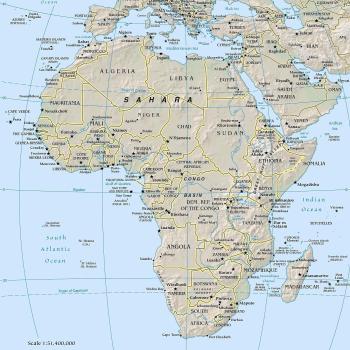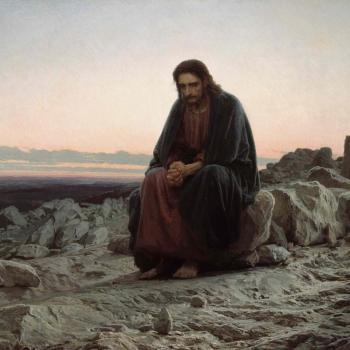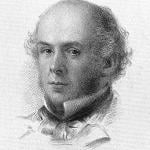Not for the first time, I am thinking about gospels, and specifically the four gospels. After so much scholarship has been undertaken through the centuries, there is not much I can add on these matters that is new, but I will make one point that seems important to me. I’ll offer an argument for the antiquity and authority of those four that is worth remembering when you next hear claims bemoaning those lost alternative gospels we hear about from time to time. Briefly, it involves a famous (and largely lost) early Christian work called the Diatessaron, the “Through Four.”
Four or More?
As everyone knows, there are four canonical gospels. A widespread popular opinion holds that this is because the Big Four are the best, the earliest, the most authentic and historical, and they have held that position for a very long time. But how long? And why were they chosen rather than others? Luke opens his gospel by acknowledging that plenty of other accounts of Jesus were in circulation, and in modern times, lots more ancient gospels have been discovered, in whole or in part. The Gospel of Thomas is one famous example, and the Gospel of Peter was another early one. So what was their relationship to the Big Four?
As I say, a conservative view suggests that these were the best-authenticated, most prestigious, and most likely to be accurate and historically plausible. A couple more night have been early contenders – the Gospel of the Hebrews often appears on this list – but otherwise, really, the four stood alone.
But there is a potent alternative view. This suggests that a great many gospels circulated together, with none enjoying any particular privilege, until the emerging church hierarchy clamped down at some particular point. Of the teeming mass of would be gospels, they selected four, perhaps because they were popular in particular centers, or else because they favored the orthodox and anti-Gnostic position about Resurrection being bodily rather than symbolic or spiritual in nature. The others were then consigned to oblivion.
As to just when that happened, some favor the Council of Nicea in the 320s (think Dan Brown), but other scholars point to one particular man, Irenaeus of Lyon, writing around 180-185. Irenaeus was a deadly enemy of heresy, and actually invented that term in its Christian sense. He also specified that the church must have four gospels, those particular four, and there could never be more than four (or, presumably, fewer). There were four winds, four cardinal points of the compass, and four gospels.
The Curse of Irenaeus
Irenaeus is a bugbear of many modern liberal thinkers. In a television interview, Elaine Pagels once remarked that Irenaeus denounces his opponents as “heretics, which means people who make choices about what to think. Irenaeus didn’t want people making choices. He wanted them thinking what the bishop told them to think” In her view, the orthodox obediently followed irrational dogmas, while heretics continued to exercise their intellects freely. His insistence on the four gospels – four alone, and definitely, specifically, no options, these – reflected that bigotry. Often, that polemic against Irenaeus focuses on gender issues, both the exclusion of women as spiritual leaders, and as the authors or subjects of gospels.
Irenaeus plays a critical role for Bart Ehrman. I have vast respect for Ehrman, for his integrity as much as his breadth of scholarship, but there are points on which I disagree with him. I was listening to a podcast in which he debated Richard Bauckham about the latter’s controversial book Jesus and the Eyewitnesses. Pardon an over-simplification, but Ehrman was (as I understand) arguing the following. There were many gospels circulating in the second century. Most or all claimed no author, and we never really know what someone is referring to when they speak about, for instance, Matthew or Mark. Only in the 180s, with the arch-heresy hunter Irenaeus, did the church concentrate so narrowly on those four gospels, and moreover (he says) they now received the names by which we know them. That was largely to confirm their authority either as apostolic sources, or as sources linked to some apostle. That reflected growing church control and institutionalization.
Supporting Ehrman’s point of view, he cited a much quoted passage from Papias, around 120, who seems to describe the gospels of Matthew and Mark. But this “Matthew” is an originally Hebrew text, which consists of logia, sayings, and is therefore nothing like the Matthew we know, which was written in Greek, and which includes a lot of narrative and a Passion scene. Score one for Bart.
I won’t address the issue of naming here at any length, except to say that Ehrman raises some excellent questions. Rather, I’ll concentrate on the question of how and when the church selected and defined the four, and that particular four. To understand this, we need to go back to Justin Martyr, who was writing between 155 and 165. Justin used the synoptics, and referred to the memoirs or recollections (apomnemoneumata) of the apostles. It’s not certain if he cites John, but he does suggest that in Rome in his time, the range of acceptable gospels was already quite limited, and moreover, that it focused on the synoptics.
Tatian and the Through Four
One of Justin’s pupils was Tatian, an “Assyrian,” born around 120, which would make him a slightly older contemporary of Irenaeus. Probably around 170, Tatian composed one of the most influential and widely circulated texts in early and medieval Christianity, namely a harmony of the gospels designed to be read together. Justin may well have had his own harmony, but this one was much more enduring, and influential. Tatian’s harmony brought together four gospels, namely the four we know well, and this became the “Through Four,” or Diatessaron. The work does not survive intact, but much of it can be reconstructed through the appearance of extracts in an astonishing range of languages worldwide: detailed reconstructions naturally vary.
Based on what we do know, the main point that must strike us is how unsurprising the text was to Christian readers over the next millennium or so, or today. What Tatian mixed and matched here was very much what would be expected to someone who knew the four canonical gospels, without any shocks or surprises – nothing like we might find from controversial texts like the Gospel of Mary or Gospel of Judas. That is an argument from silence, but it is important. If the work had contained any such material, its many critics would have jumped on it at a very early stage in its history. Either those Gnostic gospels had not been written yet, or if they had, Tatian saw no reason to take them seriously. I suspect a mixture of both reasons. He knew what real gospels looked like, and already in 170, that was what we think of today. “Gospels” meant Matthew, Mark, Luke. and John.
The name Diatessaron is not positively evidenced until the early fourth century, and that was almost certainly not the original title (Was it something like The Gospel of Jesus Christ?) . Therefore, we cannot absolutely positively say that Tatian held to a four-and-four-only view – but he was not far off. In many small instances, you can spot Diatessaronic readings because they differ from the canonical texts we know – not massively, not enough to shake the foundations of anyone’s faith, but enough to be noticed. For instance, when Jesus was baptized, then a great light or fire shone in the Jordan.
Just conceivably, Tatian might have found that point and others in another source, like the Gospel of the Hebrews, which might even have constituted a fifth source for the work. I don’t personally accept that, but I mention it for purposes of full disclosure. Even if he was drawing on G. Hebrews, the fact we find that influence so hard to spot was because so much of that otherwise lost gospel was very close to texts we have in the Big Four, particularly Matthew.
Alternatively – and this should be stressed – maybe passages like that “light shining in the Jordan” were part of the original text of one or other of the canonical gospels we have, but from which they subsequently dropped out. Tatian was after all using the gospel texts as they existed in the mid-second century, far earlier than most of our textual tradition, and he was often preserving truly primitive readings.
Tatian and Irenaeus
Note two key points about all that.
First is the date. You will see different estimates for the writing of the Diatessaron, but around 165-170 is a good consensus. If that is right, then at least a decade before Irenaeus’s famous writings, another major church luminary thought that there were four gospels, that these were the key Christian texts, and that the four were the same that we know today. Even if the dates are off a bit, and the two men were writing close to the same time, Tatian is not being influenced by Irenaeus. This does not necessarily mean that Tatian himself cooked up that list of four, any more than Irenaeus did. I assume that both men were just reflecting opinion in the churches they knew, as it stood no later than the 140s or so. Given Justin’s relative lack of interest in John, it’s interesting that this ends up as part of the Through Four.
Justin, Tatian, and Irenaeus were each in their different ways responding to the crisis brought on by Marcion of Sinope, who was a major force in the Roman church until he was expelled around 144. Marcion famously taught a stern opposition between the Old and New Testaments and their respective gods. He devised his own idiosyncratic New Testament canon using a heavily edited version of Luke (the Evangelikon) and of the Pauline epistles. That forced the orthodox to determine their own canon, which they did, and that is what drove the new emphasis on the Big Four. Conceivably, and controversially, some scholars believe that the orthodox themselves took this opportunity to add some final revisions and rewrites to the gospels as they had previously been known, in order to make the case against Marcionite readings ever more airtight. But the choice of the Four was a church consensus, rather than a bee in Irenaus’s intolerant bonnet.
Do also note that already around the 130s, even Marcion was treating one of our canonical gospels, namely Luke, as a core text, rather than choosing some now-forgotten fringe or alternative gospel. Long before Irenaeus, then, the gospels that mattered were the ones we know.
The second key point about the Diatessaron concerns orthodoxy. Let us agree that Irenaeus was the pit-bull of orthodoxy and anti-Gnosticism. Tatian was a very different character, associated with the world-rejecting movement of Encratism, which demanded celibacy, and by some accounts, he associated with the Gnostic Valentinus. Tatian, of course, did not see himself as a heretic, but the rest of the church thought he was flying far too close to Gnosticism. That is why church authorities spent a thousand years or so trying to exterminate the Diatessaron, an enterprise in which they were only partly successful, as large segments can, as I say, be reconstructed.
Among Tatian’s deadly critics was Irenaeus, who wrote,
A certain man named Tatian first introduced the blasphemy. He was a hearer of Justin’s, and as long as he continued with him he expressed no such views; but after his martyrdom he separated from the Church, and, excited and puffed up by the thought of being a teacher, as if he were superior to others, he composed his own peculiar type of doctrine. He invented a system of certain invisible Æons, like the followers of Valentinus; while, like Marcion and Saturninus, he declared that marriage was nothing else than corruption and fornication. But his denial of Adam’s salvation was an opinion due entirely to himself.
The two men were on diametrically opposed ends of the theological spectrum, they couldn’t agree on much – except that there were four real and worthwhile gospels, and they were the texts of Matthew, Mark, Luke, and John.
One other argument here concerns the Muratorian fragment, which appears to give the New Testament canon at Rome somewhere around 170 (? or 190?), and this clearly implies a four gospel sequence on the lines we know. The opening passage is missing, and we move straight into the third gospel, which is Luke: so what else might items one and two have been, except for Matthew and Mark? I note this fact, but do not lay too much weight on it because the fragment cannot be dated too exactly.
Some Conclusions
Based on all that, I would suggest:
a.That the Big Four gospels already enjoyed pride of place no later than (say) 140, and probably well before that.
b.None of the rival or alternative gospels of which we have record shows any signs of being vaguely that early, and virtually all of the ones we possess show acquaintance with one or more of the Big Four. There are a couple of non-derivative exceptions in short extracts, like the miracle in Pap. Egerton 2. (The voices in my head assure me that this is from the Gospel of the Hebrews, but I suppose that’s not hard evidence). But none of the famous “new” gospels of recent years show any hint of roots before the mid-second century at the very earliest, and most are much later. Most of the famous Nag Hammadi texts derive from the third or fourth centuries. All gospels are not created equal.
c.People in particular churches carried on reading alternative gospels through the end of the second century – Clement of Alexandria is an obvious example – but they were increasingly outliers. In particular, the Gospel of the Hebrews was amazingly persistent, and its eventual disappearance really is one of the great untold stories of the early church. When in the early fourth century Eusebius drew up his list of disputed parts of the New Testament, the antilegomena, he included the Gospel of Hebrews alongside several items that we today think of as integral parts of the canon, including Revelation, the Epistles of James and Jude, 2 Peter and 2 and 3 John, and the Epistle to the Hebrews. That’s distinguished company.
d.I don’t know why Papias writes what he did about Matthew, which is dead wrong, but the account he gives of Mark in those same writings definitely fits the Mark we know, with the overwhelming Petrine element. We also know that Mark must have been very prestigious in the late first century church, or it would not have been so extensively plundered by Matthew and Luke. So the likelihood that Papias is writing about anything other than the Mark we know is vanishingly small. I disagree with Bart Ehrman on this one.
e.Crucially, the existence of the Diatessaron confirms the early acknowledgment of four gospels, and pretty much the same four we know, quite apart from anything Irenaeus wrote or thought.
f.Any attempt to write the history of the definition of the gospel canon that gives too much play to Irenaeus and his obsessions should be treated with enormous suspicion. Anyone who tells you that the church freely accepted a whole host of gospels until 325 and the Council of Nicea knows nothing, and should be dismissed as a publican and a sinner.
g.This is speculative, but the existence of the Diatessaron surely affected concepts of what gospels looked like, and what they should include. For anyone who knew the Diatessaron, “real” gospels must look roughly like what we know – biographical format, parables and miracles, Last Supper, Passion and Resurrection – rather than the familiar Gnostic format of post-Resurrection visions and dialogues. That would also raise suspicions about other older formats, like the sayings gospels that lacked any narrative (think Thomas). If something did not more or less fit the model of what we today call a gospel, then that surely raised suspicion about its credentials. That helped draw the thickening line separating orthodox and non-orthodox texts and beliefs. I wonder in fact if that process made possible the later and much better known work of Irenaeus? Put another way, Irenaeus stands at the end of a process of the definition and defense of a gospel canon, over the previous forty years or so.
So there we have a potent argument about the Four Gospels versus the also-rans. What about the Diatessaron? Why is it the Through Four, and not (say) the Through Nineteen?
More on these matters next time.
By far the best scholarship on the Diatessaron is the book by William L. Petersen.
And an important update to the above. Recently (July) T and T Clark published a substantial collection of essays edited by Matthew R. Crawford and Nicholas J. Zola, on The Gospel of Tatian: Exploring the Nature and Text of the Diatessaron. The book looks exceptionally interesting, and it represents state of the art scholarship. I quote, “The contributors explore numerous questions: did Tatian intend to supplement or supplant the fourfold gospel? How many were his sources and how free was he with their text? How do we identify a Diatessaronic witness? Is it legitimate to use Tatian’s Diatessaron as a source in New Testament textual criticism? Is a reconstruction of the Diatessaron still possible?” I had not come across the book, but will remedy that as soon as possible.
Incidentally, Dr. Zola’s doctorate is from Baylor.
















